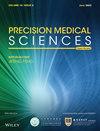Misclassification of Gleason grade and tumor stage in Asian‐American patients with low‐risk prostate cancer
IF 0.6
Q4 MEDICINE, RESEARCH & EXPERIMENTAL
引用次数: 0
Abstract
To investigate the misclassification rates of Asian‐American patients with low‐risk prostate cancer (PCa). Patients diagnosed with low‐risk PCa treated with radical prostatectomy between 2010 and 2015 in the Surveillance, Epidemiology, and End Results database were included in this study. Then, basic characteristics and pathological outcomes of the enrolled patients were retrospectively extracted. We compared the rates of upgrading and/or upstaging between Asian‐American patients and White/Black patients. Moreover, temporal trend analyses were performed to explore the changes in upgrading and upstaging rates in each race over time. Finally, logistic regression models were constructed to explore the role of Asian race in upgrading and upstaging and to screen out potential risk factors for predicting upgrading and upstaging in Asian‐American patients. Asian‐Americans had a significantly higher rate of upgrading than Whites (P < .001), while no statistical difference was found in the comparison of upstaging rate (P = .536). Moreover, Asian‐Americans were more likely to upgrade to diseases with higher ISUP grade than Whites (P = .010). The rate of upgrading increased significantly over time in White and Black patients, but not in Asian‐American patients. Finally, race seemed to be an independent risk factor for predicting upgrading, while the racial differences seemed to be more pronounced between White and Black patients. Asian‐American patients had a significantly higher rate of upgrading than White patients. Moreover, Asian‐American patients were more likely to upgrade to diseases with higher ISUP grade. Further risk assessment before clinical decision for low‐risk PCa patients with the help of significant clinical variables is required.低风险前列腺癌症亚裔美国人Gleason分级和肿瘤分期的错误分类
目的:探讨亚洲-美国低危前列腺癌(PCa)患者的误诊率。2010年至2015年间在监测、流行病学和最终结果数据库中诊断为低风险前列腺癌并接受根治性前列腺切除术的患者纳入本研究。然后,回顾性提取入组患者的基本特征和病理结果。我们比较了亚裔美国患者和白人/黑人患者的升级率和/或升级率。此外,还进行了时间趋势分析,以探讨各种族的升级率和占优率随时间的变化。最后,我们构建了逻辑回归模型来探讨亚洲种族在升级和升级中的作用,并筛选预测亚裔美国患者升级和升级的潜在危险因素。亚裔美国人的升级率明显高于白人(P < .001),而在占优率的比较中没有统计学差异(P = .536)。此外,亚裔美国人比白人更有可能升级到ISUP级别更高的疾病(P = 0.010)。随着时间的推移,白人和黑人患者的升级率显著增加,但亚裔美国患者没有。最后,种族似乎是预测升级的独立风险因素,而白人和黑人患者之间的种族差异似乎更为明显。美籍亚裔患者的升级率明显高于白人患者。此外,亚洲-美国患者更有可能升级为更高ISUP级别的疾病。在低风险PCa患者的临床决策前,需要在重要临床变量的帮助下进行进一步的风险评估。
本文章由计算机程序翻译,如有差异,请以英文原文为准。
求助全文
约1分钟内获得全文
求助全文

 求助内容:
求助内容: 应助结果提醒方式:
应助结果提醒方式:


